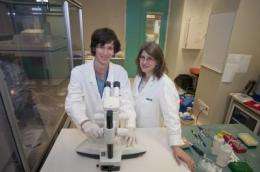Gates open on understanding potassium channel controls

Walter and Eliza Hall Institute scientists have made a significant advance in understanding how potassium channels, which permit the flow of electric currents central to many of the body's biological processes, control the flow of these currents.
Dr Jacqui Gulbis from the institute's Structural Biology division, who led the research, said previous studies that had identified what potassium channels look like had provided valuable insights into how they work. However, the way the channels open and close in response to regulatory signals has not been well understood.
"Potassium currents are central to many cellular processes, and particularly communication between cells," Dr Gulbis said.
"In the central nervous system, for example, electrical signaling underlies perception and movement; whilst in the heart, cardiac contraction relies upon the rhythmic ebb-and-flow of potassium. The electricity comes from the tiny charge associated with each potassium ion.
"Just as one would use a light switch to turn electrical current on and off, potassium channels use molecular gates to switch conduction on and off in response to physiological signals," Dr Gulbis said. "However, the nature of the gates and the gating process has remained unclear."
Potassium channels are specialised pores in cell membranes. They have a signature region termed the ion selectivity filter, which is responsible for ensuring that only potassium, and not sodium, permeates the membrane.
Dr Gulbis, with Mr Oliver Clarke, Dr Brian Smith and Mr Alex Caputo from the institute's Structural Biology division, in collaboration with Dr Jamie Vandenberg and Dr Adam Hill from the Victor Chang Cardiac Research Institute, has illuminated key aspects of the gating process.
Although previous studies have implicated a constriction in the ion conduction pathway in gating, this study describes a gate that is located in the ion selectivity filter.
Using the Australian Synchrotron, Dr Gulbis's team determined that once the conformation of a regulatory domain - which is the part of the channel that sits inside the cell - changes, it allows the selectivity filter to act as an on/off switch.
The findings have been published today in the journal Cell.
Provided by Walter and Eliza Hall Institute















